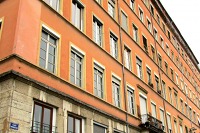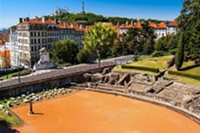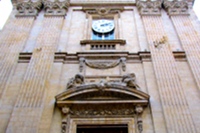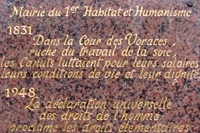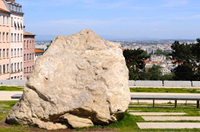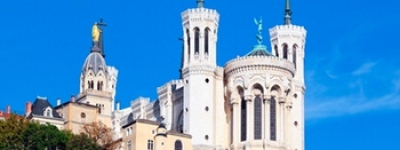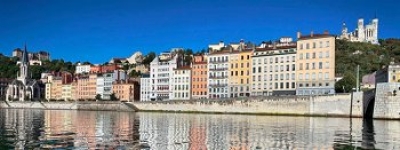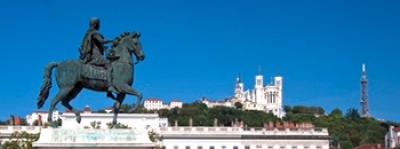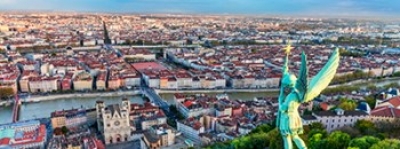The people of Lyon say that the Fourvière is where you pray, the Croix-Rousse is where you work.
The district of Croix-Rousse extends the Presqu’Ile (the peninsula) northward between the Saône and Rhône, the slopes of the Croix-Rousse on the plateau of the same name defines the perimeter of the World Heritage site to the north. The name of the neighborhood supposedly comes from a cross erected in 1560 in tones red.
History
This neighborhood wasn’t included in the city until the 19th century. Before the plateau was located outside the city walls. It was a rural, wine-growing area.
It is in this area that the silk workers, or canuts, settled. The industrial architecture of the habitats is typical of this activity: high buildings with many windows, no frills. The steep terrain favored the construction of winding streets on the hillside, and are connected by the famous “traboules” (passageways) to facilitate pedestrian traffic.
The Subsistances
8 bis Quai Saint-Vincent, 69001 Lyon
Website - tel : 04 78 39 10 02
Before becoming a place of artistic expression, the site had been occupied since the 17th century by the convent of Sainte-Marie des Chaînes. During the 19th century and until 1995 it was transformed into an industrial bakery.
The Subsistances has housed the Ecole Nationale des Beaux-Arts in Lyon since 2007. It is also a cultural venue for artistic production in the fields of dance, theater and circus.
Eglise Saint Bruno des Chartreux
7 Impasse des Chartreux 69001 Lyon
Website - tel: 04 78 64 28 32.
Open daily from 3 p.m. to 5 p.m. except on Sunday.
Guided tour available. Wheelchair accessible.
From the 16th century onward, many religious communities settled on the slopes of the Croix-Rousse. Among them, the Carthusian monks from Grenoble. Their property would quickly expand to reach 24 hectares. In 1590, the first wave of construction began on the church. For a century they would work to build the choir, the small cloister and sacristy. In the 18th century a second campaign of work would lead to the completion of the nave, transept and side chapels. The church became a jewel of baroque art.
The renovations and additions during the 19th century would focus primarily on the chapels and the facade.
Exterior
Originally the facade was sober but the restorations undertaken in 1871 would alter its appearance. The portal at the church entrance is flanked by Ionic columns and Doric pilasters. Above the entrance gate, there is a quote in Latin meaning "Come to me, you who are weary and burdened, I'll give you rest." This quote refers to the financial help the weavers were asked to contribute to pay for the work of the facade. The second floor has a few elements of the original facade, and is topped by a triangular pediment throne featuring the symbol of the Holy Spirit. Finally, the statue of Saint Bruno, including his initials, is located on the upper level.
Interior
In the choir, the stalls and woodwork are carved in a Rococo style, very fashionable at the time.
The magnificent transept (18th century) houses statues of Saint Bruno and Saint John the Baptist (1628), and are a magnificent example of the baroque sculptures of this period, with an intense expression and eyes. The altar has the particularity of being double-sided, so that ceremonies can be celebrated on the side of the monks or the side of the faithful.
The dome (1742) is 10 meters high and 39 meters in diameter. It features eight windows whose decorations show the theme of the Gospels. The side of the nave features Luke and his bull and Saint John and his eagle. On the side of the choir, Matthew and his angel are shown next to Saint Mark and his lion.
The organ was added in 1890.
Maison Brunet ou Maison aux 365 fenêtres
Place Rouville, 69001 Lyon
Can not be visited.
This huge house overlooking the Place Rouville was named after Mr. Brunet, a Savoyard who built it in 1810. Its originality lies in its composition: the owner wanted to build the house according to figures from the calendar. There are 365 windows for each day of the year, 52 apartments for each week of the year, 7 levels for each day of the week, and four entrances for the four seasons.
This silk workshop made history during the first uprising of weavers in 1831, when the building was then transformed into a fortress by the weavers who were entrenched there. The house is known as the "Citadel of the People."
Amphithéâtre des Trois Gaules
Rue Lucien Sportisse, 69001 Lyon
At the time of construction of the Amphitheater of the 3 Gauls in 19 AD, a Gallic oppidum named Condate existed close by but it was far from Lugdunum, the Roman city of Fourvière. Under the reign of Hadrian, in the following century, the amphitheater was enlarged and could accommodate nearly 20,000 people who attended shows and circuses. Every year, 60 Gallic nations gathered there to renew their allegiance to Rome. Saint Pothin, first bishop of Lyon and a pioneer in spreading the Christian ideas of the time, died a martyr in this amphitheater with 47 other people.
The few remnants that still exist today (the retaining walls) are integrated in the Jardin des Plantes.
Montée de la Grande Côte
69001 Lyon
The Rise of the Grande Côte is one of the first inhabited areas of the Croix-Rousse, from the 16th century. Some of the facades have mullioned windows, typical of this period. Apart from some religious communities that invested in the hill, the rest of the neighborhood was essentially urbanized from the 18th century. At the end of this century, the neighborhood already had more than 700 looms and the Rise of the Grande Côte, called the Grand'Côte at the time, was then an axis of passage for silk workers on the road to the trading district (Capuchin). At the top of the climb, there is a beautiful panorama of the city from the esplanade, as well as landscaped gardens created in the late 20th century. Today the street is exclusively pedestrian for the delight of visitors who can stroll along the art boutiques or take a break in the many cafés and restaurants that open onto the street. Warning: it is easy to fall under the spell of the street and this district.
Eglise Saint Polycarpe
25 Rue René Leynaud, 69001 Lyon
Tel : 04 78 39 01 06.
Visits on Tuesdays, Wednesdays and Friday mornings.
The Church of Saint Polycarp (17th century) is surprising, it is both dug into the hill and enclosed by houses. From the outside you will notice that its monumental facade (18th century) is surmounted by a triangular pediment. In the early 19th century the church was enlarged; the transept, dome and choir date back to period. The jewel of the church is its organ, created by Lyon resident Augustin Zeiger in 1841.
La Cour des Voraces
9 Place Colbert, 69004 Lyon
The Courtyard of Voraces is accessed by the building at No. 9 Place Colbert, built in 1840. A workshop of weavers, grouped into a cooperative, nicknamed Voraces, was located on the ground floor.
It would seem that the revolt of the silk workers of 1848-1849 was organized from this courtyard, one of the largest revolts in the 19th century. A plaque on the site states that "In the Courtyard of Voraces, hub of silk work, the silk workers fought for their lives and their dignity." This courtyard alone symbolizes the history of the area, its businesses and its people.
This is undoubtedly the most famous and most beautiful traboule (passageway) with its courtyard and grand staircase. This traboule leads to the Saint Sebastien Rise at No. 14 bis or to the Rue Imbert-Colomès at No. 29.
There is also a second traboule adjacent to No. 20 on Rue Imbert-Colomès that emerges at No. 55 Rue des Tables Claudiennes. This traboule is a continuation of the previous one. By taking the stone staircase, you are led to a small courtyard before reaching the Rue des Tables Claudiennes.
Le Gros Caillou
180 Boulevard de la Croix-Rousse, 69001 Lyon
This rock was extracted during the construction of the funicular. According to scientists, this stone came to Lyon from the Alps, transported by glaciers (boulder). According to local legend, it represents the heart – of stone – of a bailiff punished for having driven away a family of weavers. This is an immutable reference for the residents of Lyon who often meet at this spot. It has even inspired children's literature.
From this symbol of district, visitors can enjoy a magnificent view of the surrounding area of and on a clear day, see the Alps and Mont Blanc.



